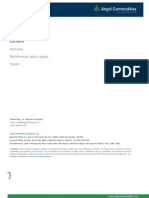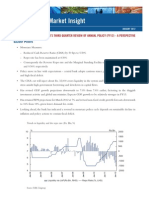Economics Club: Article Series - 2
Economics Club: Article Series - 2
Uploaded by
Rahul SharmaCopyright:
Available Formats
Economics Club: Article Series - 2
Economics Club: Article Series - 2
Uploaded by
Rahul SharmaOriginal Description:
Original Title
Copyright
Available Formats
Share this document
Did you find this document useful?
Is this content inappropriate?
Copyright:
Available Formats
Economics Club: Article Series - 2
Economics Club: Article Series - 2
Uploaded by
Rahul SharmaCopyright:
Available Formats
Reach out at: ecoclub@email.iimcal.ac.
in
Economics Club
ARTICLE SERIES – 2
Aug 11 – Aug 17 (2019)
Economics Club
Rupee’s downfall worsens in August
On July 31, the rupee closed at 69.405 to a dollar. Fast forward to 15 August, and it was 71.532. That’s
approximately 3.2% decline in the value of rupee in just over 15 days. This makes our currency the worst
performer across the continent. But why is this happening? Well, let’s connect the dots.
Investors around the world are becoming cautious because of the global economic slowdown. Numbers
aren’t giving any cheer, and the uncertainty around the US-China trade war makes it even worse. In spite
of all this, India offers a relatively better rate of return as compared to several other nations, some of
which, offers a negative yield. But RBI cut its benchmark repo rate just a week ago by 35 bps. This,
coupled with the instability in the nation due to Kashmir decision, does not bode well for investors looking
for opportunities in the Indian market.
All of this triggered a massive sell-off in the Indian equity market with FPIs selling $1.6 billion worth of
equity in just August itself. Where is the money flowing to? One answer can be safe assets like bonds and
gold (prices are at a six-year high) which are considered as safe-haven assets.
So, what does the future hold now? Well, there are no clear signs of relief or optimism in the market. One
thing that can probably work in favor of India is a positive looking policy from the finance ministry intended
towards foreign investors.
Ali Pulavwala MBA1
Economics Club
Policy cut Transmission
Following the meeting of MPC on August 7, the RBI in its fourth consecutive cut lowered the repo rate by 35
bps to 5.4%. But a rate cut is only effective if commercial banks cut their lending and deposit rates and pass
on the benefits of lowered rate to their customers (known as TRANSMISSION).
Transmission of rate cuts has always been a challenge for the government. Since February, the RBI has cut
repo rate by 75 bps (excluding the latest cut of 35 bps), but the transmission has happened for only 29 bps.
The major reason for such a sheepish response by the banks is reduced difference between the deposit
rates and credit growth rates. Lower growth rate numbers coupled with lower deposit rate puts pressure of
the banks to maintain their steady operating margins. Moreover, the interest rates in small saving remain
high, which makes it all the more difficult for the banks to cut their deposit rates. Both the factors have limited
the transmission of rate cuts in the same proportion. Also, the quantum of funds sourced by the banks
through the repo window is small as compared to the funds from the bank deposits. Therefore, it becomes
practically unviable for the banks to borrow from the RBI and simultaneously maintain a 4% CRR carrying no
return whatsoever.
Though the ultimate aim of such rate cuts is to boost consumption, growth and investment numbers in the
economy, recent rate cuts have not been entirely successful in doing so because of poor transmission record
of the banks. Therefore, to restore customer confidence and boost private investment before the festive
season kick-starts in September, commercial banks should work in tandem with the central bank to
successfully transmit the benefits of repo rate cuts to the ultimate consumers.
Kartik Singhal MBA1
Economics Club
Federal Reserve Rate cut
The Federal Reserve cut interest rates by 25 bps, citing “Signs of a global slowdown, simmering U.S.
trade tensions and a desire to boost too-low inflation in explaining the central bank's decision to lower
borrowing costs for the first time since 2008.”
This is supposed to be a precautionary move to respond to weakness in the global economy, which could
potentially hit demand for US Exports and slow the internal economy. Furthermore, since most nations had
already cut their interest rates in anticipation of a Fed cut, not following suit would have led to a
strengthening of the dollar and a reduced demand for US goods abroad.
Lower interest rates prompt more spending by the Fed on government securities (Quantitative easing)
which in turn increases the money supply.
Under attack from Donald Trump since the last two months, the chairman of the Fed, Jerome Powell,
continues to attract criticism as the white house desires a greater cut, to boost business sentiment despite
indicators like employment and stock indexes being at an all-time high.
While the Fed doesn't have enough powers by itself to stave off a recession, another rate cut is expected
in the future to counter investor pessimism and global slowdown.
Udit Miglani MBA1
You might also like
- Blackhealth Manufacturing Company-RevisitedDocument8 pagesBlackhealth Manufacturing Company-RevisitedRahul Sharma100% (1)
- Kepler CannonDocument2 pagesKepler CannonRahul SharmaNo ratings yet
- Daily Lesson Plan Subject: English Form Date Teacher Lessontopic Lesson Type SubcompetencesDocument3 pagesDaily Lesson Plan Subject: English Form Date Teacher Lessontopic Lesson Type SubcompetencesDianaGanteaNo ratings yet
- Slide - 1: 2009. Between March 2010 and October 2011 The Reserve Bank Raised Its Policy RepoDocument3 pagesSlide - 1: 2009. Between March 2010 and October 2011 The Reserve Bank Raised Its Policy RepoGarrima ParakhNo ratings yet
- RBI Monetary Policy UpdateDocument4 pagesRBI Monetary Policy UpdateAngel BrokingNo ratings yet
- RBI Springs Surprise, Cuts Repo by 50 Bps by Dinesh Unnikrishnan & Anup RoyDocument5 pagesRBI Springs Surprise, Cuts Repo by 50 Bps by Dinesh Unnikrishnan & Anup RoymahaktripuriNo ratings yet
- News Round Up: Month at GlanceDocument1 pageNews Round Up: Month at GlanceSwapnil ShethNo ratings yet
- 21MAYDocument3 pages21MAYritudahiya1389No ratings yet
- Week Ended September 21, 2012: Icici Amc Idfc Amc Icici BankDocument4 pagesWeek Ended September 21, 2012: Icici Amc Idfc Amc Icici BankBonthala BadrNo ratings yet
- RBI Monetary Policy Review, 17th June 13Document5 pagesRBI Monetary Policy Review, 17th June 13Angel BrokingNo ratings yet
- Case Builds For A Rate Cut: Liquidity Conditions Remain EasyDocument3 pagesCase Builds For A Rate Cut: Liquidity Conditions Remain EasyHimanshu JhambNo ratings yet
- Credit Policy 5 Reasons Why RBI Is Unlikely To ActDocument2 pagesCredit Policy 5 Reasons Why RBI Is Unlikely To ActShwetabh SrivastavaNo ratings yet
- Market Outlook 31st DecDocument12 pagesMarket Outlook 31st DecAngel BrokingNo ratings yet
- Key Highlights:: Inflationary Pressures Overrides Downside Risks To GrowthDocument6 pagesKey Highlights:: Inflationary Pressures Overrides Downside Risks To Growthsamyak_jain_8No ratings yet
- Market Insight Q3FY12 RBI Policy Review Jan12Document3 pagesMarket Insight Q3FY12 RBI Policy Review Jan12poojarajeswariNo ratings yet
- Presentation ON An Overview of Monetary PolicyDocument22 pagesPresentation ON An Overview of Monetary PolicybhoopendratNo ratings yet
- RBI Monetary Poilcy ReviewDocument3 pagesRBI Monetary Poilcy ReviewAngel BrokingNo ratings yet
- An Smu Economics Intelligence Club ProductionDocument10 pagesAn Smu Economics Intelligence Club ProductionSMU Political-Economics Exchange (SPEX)No ratings yet
- Indian Banks Loan Growth RateDocument4 pagesIndian Banks Loan Growth RateKabilanNo ratings yet
- The World Economy... - 06/04/2010Document2 pagesThe World Economy... - 06/04/2010Rhb InvestNo ratings yet
- RBI Monetary Policy - August 17Document3 pagesRBI Monetary Policy - August 17pappuNo ratings yet
- The Ageing RupeeDocument2 pagesThe Ageing RupeeAniket PallavNo ratings yet
- Barclays Fed Cut OverviewDocument6 pagesBarclays Fed Cut Overview7flzglnNo ratings yet
- Times: Rajan Resists Govt Pressure On RatesDocument1 pageTimes: Rajan Resists Govt Pressure On RatesVibhor AggarwalNo ratings yet
- The World Economy ... - 11/03/2010Document2 pagesThe World Economy ... - 11/03/2010Rhb InvestNo ratings yet
- Monetary Policy ReviewDocument4 pagesMonetary Policy ReviewiesmcrcNo ratings yet
- Assignment 3Document5 pagesAssignment 3SuprityNo ratings yet
- 2935IIBF Vision July 2013Document8 pages2935IIBF Vision July 2013Deepika KishoreNo ratings yet
- Evolving Bond MarketDocument9 pagesEvolving Bond MarketcoolNo ratings yet
- Monetary PolicyDocument9 pagesMonetary Policytulasi nandamuriNo ratings yet
- Chairman Interview Business StandardDocument1 pageChairman Interview Business Standardsushant_shaantNo ratings yet
- India Markets BriefDocument7 pagesIndia Markets BriefKalapala SandeepNo ratings yet
- State Bank of Pakistan: Monetary Policy DecisionDocument2 pagesState Bank of Pakistan: Monetary Policy DecisionSumeet MetaiNo ratings yet
- RBI Rate Hike A GivenDocument2 pagesRBI Rate Hike A GivenMuana Lal Thla JAfNo ratings yet
- Tracking The World Economy... - 23/08/2010Document3 pagesTracking The World Economy... - 23/08/2010Rhb InvestNo ratings yet
- The Pensford Letter - 2.11.13Document4 pagesThe Pensford Letter - 2.11.13Pensford FinancialNo ratings yet
- RBG Financial News LetterDocument2 pagesRBG Financial News Lettermarketing2871No ratings yet
- Falling Rate of InterestDocument3 pagesFalling Rate of InterestrimpimannNo ratings yet
- Financial Express Mumbai 01 August 2012 6Document1 pageFinancial Express Mumbai 01 August 2012 6bhaskardoley30385215No ratings yet
- Answers To Frequently Asked Questions On "Quantitative and Qualitative Monetary Easing (QQE) With A Negative Interest Rate"Document17 pagesAnswers To Frequently Asked Questions On "Quantitative and Qualitative Monetary Easing (QQE) With A Negative Interest Rate"TBP_Think_TankNo ratings yet
- Ficc Times HTML HTML: The Key Events of Last WeekDocument6 pagesFicc Times HTML HTML: The Key Events of Last WeekMelissa MillerNo ratings yet
- FOMC Meeting Update - 14 September 2012Document3 pagesFOMC Meeting Update - 14 September 2012Angel BrokingNo ratings yet
- Eco UpdatesDocument2 pagesEco UpdatesSumit GunjanNo ratings yet
- Things To About Your AudienceDocument8 pagesThings To About Your AudiencepavittraNo ratings yet
- Monetary Policy and Role of Banks: February 2015Document7 pagesMonetary Policy and Role of Banks: February 2015anik24No ratings yet
- Tracking The World Economy... - 13/12/2010Document3 pagesTracking The World Economy... - 13/12/2010Rhb InvestNo ratings yet
- Ficc Times: The Week Gone by and The Week AheadDocument5 pagesFicc Times: The Week Gone by and The Week Aheadr_squareNo ratings yet
- Financial Articles: MembersDocument6 pagesFinancial Articles: MembersSwapnil ChavanNo ratings yet
- The World Economy... - 7/7/2010Document3 pagesThe World Economy... - 7/7/2010Rhb InvestNo ratings yet
- ANZ QR Indonesia Policy 19092019Document4 pagesANZ QR Indonesia Policy 19092019Handy HarisNo ratings yet
- New Repo and Reverse Repo RatesDocument2 pagesNew Repo and Reverse Repo RatesbankportalibpsNo ratings yet
- Tracking The World Economy... - 13/08/2010Document3 pagesTracking The World Economy... - 13/08/2010Rhb InvestNo ratings yet
- FixedIncome January 2012Document3 pagesFixedIncome January 2012jayaram_mca83No ratings yet
- We Expect Liquidity To Be Tight Till December, at Least. - J P MorganDocument5 pagesWe Expect Liquidity To Be Tight Till December, at Least. - J P MorganAlpesh PatelNo ratings yet
- Treasury Weekly Report W-26Document3 pagesTreasury Weekly Report W-26shyamalNo ratings yet
- FICC Times!Document6 pagesFICC Times!r_squareNo ratings yet
- Retail Research Weekly Debt ReportDocument12 pagesRetail Research Weekly Debt ReportGauriGanNo ratings yet
- Finance 2015 v1 PDFDocument2 pagesFinance 2015 v1 PDFAnonymous SFaEWb9XNo ratings yet
- Policy On The Hop?: Cleaning Up PowerDocument1 pagePolicy On The Hop?: Cleaning Up PowerAshokKumarBairwaNo ratings yet
- Global Financial and Economic Crisis: Impact On India and Policy ResponseDocument7 pagesGlobal Financial and Economic Crisis: Impact On India and Policy ResponseVivek MahalaNo ratings yet
- Stint Giggly Cuddling Inculcate Cognizance Strategy Focus AugmentDocument8 pagesStint Giggly Cuddling Inculcate Cognizance Strategy Focus AugmentAbidRazacaNo ratings yet
- Jayashree Polymers Private Limited: Ratings Withdrawn Summary of Rating ActionDocument5 pagesJayashree Polymers Private Limited: Ratings Withdrawn Summary of Rating ActionRahul SharmaNo ratings yet
- Bharat Lodha: Print Media Client Auto Parts Mfg. ClientDocument1 pageBharat Lodha: Print Media Client Auto Parts Mfg. ClientRahul SharmaNo ratings yet
- Shalini Matta (0366/54)Document1 pageShalini Matta (0366/54)Rahul SharmaNo ratings yet
- Aditya Walke (0303/54)Document1 pageAditya Walke (0303/54)Rahul SharmaNo ratings yet
- Abhay Chandra (0305/54)Document1 pageAbhay Chandra (0305/54)Rahul SharmaNo ratings yet
- The Future of The Middle Class: February 2020Document40 pagesThe Future of The Middle Class: February 2020Rahul SharmaNo ratings yet
- Converging Megatrends: Key Strategies To Deploy in This Era of Influencer MarketingDocument22 pagesConverging Megatrends: Key Strategies To Deploy in This Era of Influencer MarketingRahul SharmaNo ratings yet
- CRISIL Fund Insights Feb2020Document4 pagesCRISIL Fund Insights Feb2020Rahul SharmaNo ratings yet
- CRISIL Fund Insights Mar2020Document4 pagesCRISIL Fund Insights Mar2020Rahul SharmaNo ratings yet
- Elliott Letter To Marathon Nov 2016Document4 pagesElliott Letter To Marathon Nov 2016Rahul SharmaNo ratings yet
- BMC Letter To Shareholders Regarding Elliott Jun 2012Document11 pagesBMC Letter To Shareholders Regarding Elliott Jun 2012Rahul SharmaNo ratings yet
- Serial Number3 - 201502Document2 pagesSerial Number3 - 201502Rahul SharmaNo ratings yet
- 96 PlansDocument168 pages96 PlansRahul SharmaNo ratings yet
- CASE 1-1: Preteen Market-The Right Place To Be in For Cell Phone Providers?Document96 pagesCASE 1-1: Preteen Market-The Right Place To Be in For Cell Phone Providers?Rahul SharmaNo ratings yet
- The Good Will and The Categorical Imperative: Immanuel KantDocument6 pagesThe Good Will and The Categorical Imperative: Immanuel KantRahul SharmaNo ratings yet
- Motivation: Prof. Leena ChatterjeeDocument29 pagesMotivation: Prof. Leena ChatterjeeRahul SharmaNo ratings yet
- 01 Indian Legal System 2018Document37 pages01 Indian Legal System 2018Rahul SharmaNo ratings yet
- Apna DukanDocument219 pagesApna DukanRahul SharmaNo ratings yet
- Interpersonal CommunicationDocument8 pagesInterpersonal CommunicationRahul SharmaNo ratings yet
- The Ancient Astronomy of Easter Island: Aldebaran and The PleiadesDocument28 pagesThe Ancient Astronomy of Easter Island: Aldebaran and The PleiadesvalentinoNo ratings yet
- SRDC1 ORpostsDocument62 pagesSRDC1 ORpostsapi-3816484100% (2)
- SOLUTION TO ASSIGNMENT FOR DISCUSSION (Chapters 1,2,3 and 4)Document17 pagesSOLUTION TO ASSIGNMENT FOR DISCUSSION (Chapters 1,2,3 and 4)ArtisanNo ratings yet
- Hero Honda Company: Report of In-Plant TrainingDocument19 pagesHero Honda Company: Report of In-Plant TrainingRamchandra kaulage.No ratings yet
- World Religions: Buddhism Study GuideDocument2 pagesWorld Religions: Buddhism Study GuideMonikaNo ratings yet
- Its Not Our Shame, Its Your Shame Says Shenaz Treasurywala To PM ModiDocument12 pagesIts Not Our Shame, Its Your Shame Says Shenaz Treasurywala To PM ModiJitendra Suraaj TripathiNo ratings yet
- Eusebio Vs Eusebio - G.R. No. L-8409. December 28, 1956Document5 pagesEusebio Vs Eusebio - G.R. No. L-8409. December 28, 1956Ebbe DyNo ratings yet
- A Cross-Sectional Survey of Knowledge, Attitude and Practice Associated With COVID-19 Among Undergraduate Students in ChinaDocument8 pagesA Cross-Sectional Survey of Knowledge, Attitude and Practice Associated With COVID-19 Among Undergraduate Students in Chinaandris mejia alvarezNo ratings yet
- RubaiyatDocument31 pagesRubaiyatChique LabuguenNo ratings yet
- Reports 2Document10 pagesReports 2Tejaswini ReddyNo ratings yet
- Makalah Bahasa Inggris HukumDocument10 pagesMakalah Bahasa Inggris HukumOakley OsfredoNo ratings yet
- 20BCS2334 Jitesh KumarDocument4 pages20BCS2334 Jitesh KumarjiteshkumardjNo ratings yet
- Homework Solutions For Chapter 6Document8 pagesHomework Solutions For Chapter 6api-234237296No ratings yet
- FACTS: Victoria K. Mapua (Mapua) Alleged ThatDocument3 pagesFACTS: Victoria K. Mapua (Mapua) Alleged ThatmgeeNo ratings yet
- (Med Juris) Chapter 22-25-Atty. Yulo, MD (MCKB)Document5 pages(Med Juris) Chapter 22-25-Atty. Yulo, MD (MCKB)CRUZ Jill EraNo ratings yet
- The Role of Context in Pragmatics Interpretations of Learning EnglishDocument12 pagesThe Role of Context in Pragmatics Interpretations of Learning EnglishFernando Navarro QuirizNo ratings yet
- DR - Ram Manohar Lohiya National Law University: Hate Speech: Misuse of Freedom of Speech and ExpressionDocument12 pagesDR - Ram Manohar Lohiya National Law University: Hate Speech: Misuse of Freedom of Speech and ExpressionAniket SachanNo ratings yet
- Magic of GreyhawkDocument53 pagesMagic of GreyhawkEric MonachonNo ratings yet
- Maslow's Theory of Human Motivation PDFDocument2 pagesMaslow's Theory of Human Motivation PDFnagarajhebbarNo ratings yet
- Metaphor ThesisDocument430 pagesMetaphor Thesisshiraaaz100% (1)
- Publix LawsuitDocument56 pagesPublix LawsuitThe LedgerNo ratings yet
- Chapter 10 20 Social LegislationDocument19 pagesChapter 10 20 Social LegislationKyle ParisNo ratings yet
- Creeping Flow in Two-Dimensional Network - 1982Document29 pagesCreeping Flow in Two-Dimensional Network - 1982Alireza Attari MNo ratings yet
- Learning Module in Ed 103Document80 pagesLearning Module in Ed 103Anazel RadaNo ratings yet
- Grade 12 - MarketingDocument11 pagesGrade 12 - MarketingMicah Armada GadeNo ratings yet
- 35 Years of Studies On Business Failure - An Overview of The Classic Statistical Methodologies and Their Related ProblemsDocument31 pages35 Years of Studies On Business Failure - An Overview of The Classic Statistical Methodologies and Their Related ProblemsGaMer LoidNo ratings yet
- Structure and Participants of Foreign Exchange MarketDocument3 pagesStructure and Participants of Foreign Exchange Marketvijayadarshini vNo ratings yet
- The Saturn Myth David N Talbott 1980Document254 pagesThe Saturn Myth David N Talbott 1980R100% (1)
- Protocol OfficerDocument4 pagesProtocol OfficerKashif Imran100% (1)














































































































